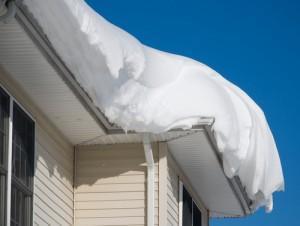 Ice dams are an all too common occurrence in Boston, especially with the snow we’ve had this year. Cold, snowy winters and warm homes are the perfect recipe for these, at best, nuisances, at worse, disasters. Though they may be inevitable, there are steps you can take to protect your home and minimize damage. Use our tips on ice dam prevention on Massachusetts homes and breathe a little bit easier every time a big storm hits.
Ice dams are an all too common occurrence in Boston, especially with the snow we’ve had this year. Cold, snowy winters and warm homes are the perfect recipe for these, at best, nuisances, at worse, disasters. Though they may be inevitable, there are steps you can take to protect your home and minimize damage. Use our tips on ice dam prevention on Massachusetts homes and breathe a little bit easier every time a big storm hits.
Ice Dam Prevention On Boston Area Homes
Scrape Snow.
Use a snow rake or a push broom to clear snow from the bottom 3-6 feet of your roof. Stand below the level of the roof and pull snow towards the ground and off of the roof. This works well for small to medium-sized snowfalls. Once you get into snowfalls of several feet, it becomes more dangerous. While some people suggest standing on the roof and shoveling snow off, this is much more dangerous, particularly if you have a steep pitch. Flat roofs are better suited for this type of clearing. If you ever do need to stand on the roof to remove snow, make sure you have a safety line and someone on hand to help you or call in a professional.
Clear Gutters and Downspouts.
Ice dam prevention starts long before the first snowflake falls. Clear out your gutters and downspouts in the fall to provide water with a place to go.
Seal the House.
Ice dams form when warm air from inside the home escapes to the attic, heats the roof, and causes snow that is on the roof to melt. That melted snow then refreezes at the edge of the roofline and forms an ice dam. By sealing points of entry for warm air to get into the attic, you can keep the roof temperature closer to the outside air temperature and prevent ice dams. Common points of entry include exhaust fans, vent pipes, chimneys, attic hatches, and electrical fixtures.
Insulate.
Additional insulation has a similar effect to sealing the air leaks – it reduces heat convection between the warmer interior of the home and the uninsulated attic.
Vent the Attic.
Increasing airflow into and out of the attic helps regulate the temperature too, keeping the inside cooler which can help prevent snow from melting.
Replace the Roof.
A drastic, but effective choice is to replace an asphalt roof with a standing seam metal roof. Seams run vertical to the roofline and are situated above the flat level of the roof. This provides extra protection because there aren’t any gaps under which water can infiltrate and freeze, creating the ice dam. A similar solution would be to replace just the bottom 3 or 4 feet of roof with a metal drip edge.
Water-Repellent Membranes.
Have water repellent membranes installed under your asphalt shingles when they are replaced. This helps protect the underlying structure from water that backs up behind the ice dam by forming a protective barrier.
Getting Professional Help
If ice dams have already formed, you can’t perform the preventative measures yourself, or you want to have your home inspected for ice dam risks, contact GF Sprague. We have 45 years of experience with ice dam prevention in Massachusetts and can often take care of the problem permanently. Call us to arrange an inspection or to discuss your situation.
